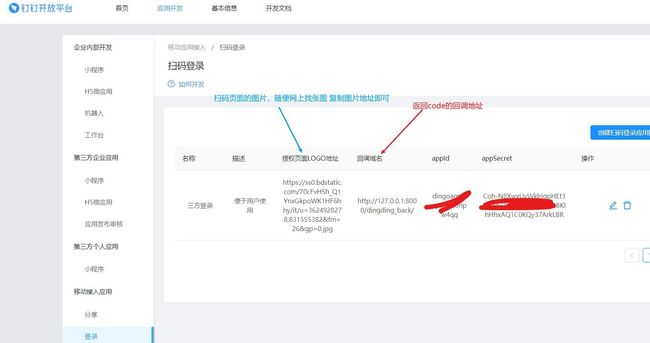Python 实现钉钉三方登录
登录流程图
注册钉钉
1.1钉钉作为阿里旗下的一款免费移动通讯软件,受众群体越来越多,这里我们使用DJANGO来集成一下钉钉的三方账号登录,首先注册钉钉开发平台:HTTPS://OPEN-DEV.DINGTALK.COM/
1.2 创建应用
代码
# 构建一个钉钉类
class DingDing:
# 拼接url
# 构造钉钉登录url
def ding_url(request):
appid = 'dingoagmvzpdwxx5npw4qqx' # 应用中的appid
redirect_uri = 'http://127.0.0.1:8000/dingding_back/' #钉钉返回信息的回调地址
return redirect('https://oapi.dingtalk.com/connect/qrconnect?appid=' + appid + '&response_type=code&scope=snsapi_login&state=STATE&redirect_uri=' + redirect_uri)
# 构造钉钉回调方法
def ding_back(request):
# 获取code
code = request.GET.get("code")
t = time.time()
# 时间戳
timestamp = str((int(round(t * 1000))))
appSecret = 'Coh-N8XwxUvWklrjgpHEt35zePr3l9vmTquUMPFKRBKIhHhxAQ1C0KQy37ArmLBRx'
# 构造签名
signature = base64.b64encode(
hmac.new(appSecret.encode('utf-8'), timestamp.encode('utf-8'), digestmod=sha256).digest())
# 请求接口,换取钉钉用户名
payload = {'tmp_auth_code': code}
headers = {'Content-Type': 'application/json'}
appid='dingoagmvzpdwxx5npw4qqx'
res = requests.post('https://oapi.dingtalk.com/sns/getuserinfo_bycode?signature=' + urllib.parse.quote(
signature.decode("utf-8")) + "×tamp=" + timestamp + "&accessKey="+appid,
data=json.dumps(payload), headers=headers) # accessKey=appid
# 返回的用户信息
res_dict = json.loads(res.text)
print(res_dict)
# name = res_dict['user_info']['nick']
# print(name)
# 判断对象是否存在
obj = User.objects.filter(oauth_id=res_dict['user_info']['dingId']).first()
print('obj>>>>>>', obj)
print('obj>>>>>>', obj.username)
# 如果不存在 创建新用户
if not obj:
user = User(username=res_dict['user_info']['nick'], oauth_id=res_dict['user_info']['dingId'])
user.save() # 创建新用户
obj = User.objects.filter(oauth_id=res_dict['user_info']['dingId']).first()
encode_jwt = jwt.encode({'uid': obj.id, 'username': obj.username}, settings.SECRET_KEY,
algorithm='HS256') # 加密内容,**,算法
return redirect(
'http://localhost:8080/staition?uid=' + str(obj.id) + "&username=" + obj.username + "&jwt=" + str(
encode_jwt, encoding='utf-8'))
# 否则直接返回用户名和id
encode_jwt = jwt.encode({'uid': obj.id, 'username': obj.username}, settings.SECRET_KEY,
algorithm='HS256') # 加密内容,**,算法
# 回调到前端
return redirect(
'http://localhost:8080/staition?uid=' + str(obj.id) + "&username=" + obj.username + "&jwt=" + str(
encode_jwt, encoding='utf-8'))
